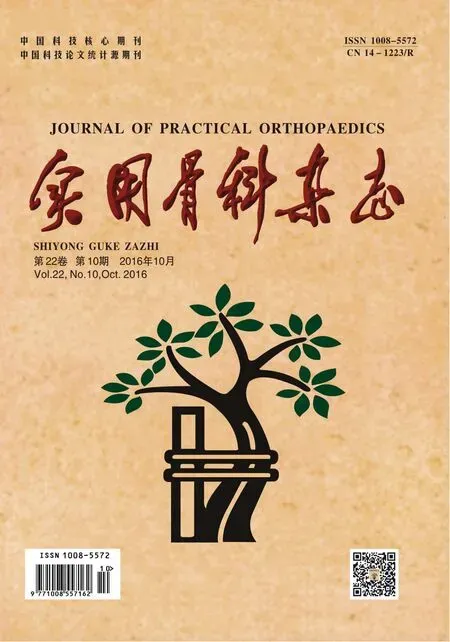240 例腰椎手術失敗綜合征的回顧性分析
王深深,賈連順,陳雄生,周盛源,王英杰
(第二軍醫大學附屬長征醫院脊柱外科,上海 200003)
?
240 例腰椎手術失敗綜合征的回顧性分析
王深深,賈連順*,陳雄生,周盛源,王英杰
(第二軍醫大學附屬長征醫院脊柱外科,上海200003)
目的對腰椎手術失敗綜合征(failed back surgery syndrome,FBSS)的原因、之前的手術方式進行分析。方法回顧性分析2003年1月至2013年12月我院骨科收治的240 例腰椎手術失敗綜合征患者的臨床資料,依據診斷的不同分為三組,組1為182 例腰椎間盤突出癥術后;組2為31 例腰椎管狹窄癥術后;組3為27 例腰椎滑脫癥術后。收集的臨床資料包括性別、年齡、術后癥狀復發時間、之前的手術方式和手術節段、入院診斷。總結分析FBSS的原因及其和之前的手術方式的關系。結果患者共240 例,男136 例,女104 例。三組原因比例最高的分別是:腰椎間盤突出復發、腰椎管狹窄、內固定失敗。三組之前的手術中比例最高的術式分別是:單純髓核摘除術、椎板切除減壓術、腰椎后路側方植骨融合內固定術。結論腰椎手術失敗綜合征的原因復雜,包括腰椎間盤突出復發、腰椎管狹窄、手術并發癥、相鄰節段退變性疾病、內固定失敗等,而合理運用手術方式或可減少腰椎手術失敗綜合征的發生。
腰椎手術失敗綜合征;原因;手術方式
腰椎手術失敗綜合征(failed back surgery syndrome,FBSS)是指在一次或多次腰椎手術后,因手術過程中對骨、軟組織正常解剖結構的破壞、神經組織的損傷等多種原因,患者術后仍存在或復發腰痛,伴或不伴坐骨神經痛、下肢感覺運動和大小便功能障礙的一類癥候群,即手術結果未達到術前患者和術者的期望值[1-2]。國外文獻報道腰椎手術失敗綜合征的發生率為5%~74.6%,再手術率為13.4%~35%[2-5]。本研究對本院240 例腰椎手術失敗綜合征的原因和之前的手術方式進行了回顧性分析,為臨床上減少FBSS的發生提供有效的預防措施。
1 資料與方法
1.1一般資料回顧分析2003年1月至2013年12月本院收治的240 例FBSS患者,其中男136 例,女104 例,年齡17~81 歲。依據診斷的不同分為三組:腰椎間盤突出癥術后組(組1)、腰椎管狹窄癥術后組(組2)、腰椎滑脫癥術后組(組3)。通過查閱所有患者的臨床資料,統計三組患者的一般資料:性別、年齡、術后癥狀復發時間、之前的手術方式和手術節段、入院診斷。
2 結 果
本研究240 例患者中,之前的手術中比例最高的術式是單純髓核摘除術。之前的手術節段中,單節段占77.8%,2節段及其以上占22.2%,其中單節段中以L4~5最多,占44%。總結分析入院診斷,發現導致FBSS發生最多的是腰椎間盤突出復發,占36.25%,其次為腰椎管狹窄,占23.75%。依據不同的分組,結果分為三部分具體詳述。患者相關資料見表1~3。

表1 患者之前手術方式的資料(例/%)

表2 患者之前的手術節段資料(例/%)
2.1腰椎間盤突出癥術后發生FBSS組1共納入患者182 例,其中男107 例,女75 例;年齡為22~79 歲,平均(52.3±11.39) 歲。之前的手術節段中,單節段占85.4%,2節段及其以上占14.6%,其中單節段中L4~5最多,占50.3%。之前的手術方式中比例最高的術式為單純髓核摘除術。患者術后癥狀復發的中位數時間為48個月。

表3 三組患者FBSS原因比較(例/%)
2.2腰椎管狹窄癥術后發生FBSS組2共納入患者31 例,男18 例,女13 例;年齡為39~81 歲,平均(60.2±9.68) 歲。之前的手術節段中,單節段占37.5%,2節段占37.5%,3節段及其以上占25%,其中單節段中L4~5最多,占29.1%。之前的手術方式中比例最高的術式:全椎板/半椎板切除減壓術。患者術后癥狀復發的中位數時間為18個月。
2.3腰椎滑脫癥術后發生FBSS組3共納入患者27 例,男11 例,女16 例;年齡為17~69 歲,平均(51.3±12.64) 歲。之前的手術節段中,單節段占69.6%,2節段及其以上占30.4%,其中單節段中L5S1最多,占52.2%。原因為內固定失敗或腰椎滑脫加重的16 例患者,之前的手術中后路單純植骨融合2 例,椎弓根螺釘內固定術或腰椎后路側方植骨融合內固定術12 例,腰椎后路椎間植骨融合內固定術2 例。之前的手術方式中比例最高的術式:腰椎后路側方植骨融合內固定術。患者術后癥狀復發的中位數時間為18個月。
典型病例:a)42 歲女性患者,3年前因L4~5椎間盤突出行單純髓核摘除,半年前出現左下肢酸痛、麻木。在我院采用椎間植骨融合加椎弓根螺釘內固定術治療,手術前后影像學資料見圖1~2。b)63 歲女性患者,19年前外傷后出現腰部酸痛,伴雙下肢酸麻,以左下肢為重。于當地醫院行腰椎滑脫手術治療(具體不詳),術后患者腰痛緩解,但反復發作。4個月前加重,于當地醫院行腰椎后路內固定術,術后腰痛緩解,但左下肢仍感酸麻,出現間歇性跛行。在我院行腰椎后路左側內固定取出加椎板間植骨融合術,手術前后影像學資料見圖3~4。
3 討 論
腰椎手術技術近數十年發展迅速,從單純髓核摘除到椎板切除減壓、椎間融合器植入、椎弓根螺釘內固定術,手術方式越來越成熟。并且近年來在全國各地新開展了腰椎微創技術,如射頻消融術、經皮穿刺髓核溶解術、內鏡下椎間盤切除術、通道下髓核摘除經皮螺釘內固定等。雖然腰椎手術技術有顯著提高,但腰椎術后仍有一些患者癥狀沒有緩解或復發。
腰椎間盤突出癥術后發生FBSS的首要原因是腰椎間盤突出復發[6,7]。據相關文獻報道,腰椎間盤突出癥術后復發率從1%~21%不等[8-10]。有文獻報道,重體力勞動和吸煙是導致腰椎間盤突出復發的兩個主要危險因素[11]。組1有85 例腰椎間盤突出復發,占總數的46.7%,是單純髓核摘除術后發生FBSS的主要原因。
腰椎間盤突出癥術后發生FBSS的第二大原因是相鄰節段退變性疾病(adjacent segment disease,ASD)。ASD是腰椎融合術后常見的并發癥,其發生率為1.8%[12]。其發生與相鄰節段本身存在退變、之前的手術對相鄰節段的破壞和術后該節段活動度的增大有關。有學者認為開放性手術相比經皮術式更容易發生相鄰節段退變性疾病,因為開放性手術對椎旁肌肉和韌帶的損傷更大[8-9,13-14]。最新的Meta分析發現[12],多節段的腰椎融合是發生ASD的高風險因素,因此建議在腰椎長節段的手術中應減少融合節段,并盡量減小對相鄰節段小關節和后方韌帶復合體的破壞,重建棘上韌帶以增加腰椎的穩定性,還可以使用各種非融合技術,比如經腰椎后路的動態固定技術等,通過保留手術節段的活動度,減小術后ASD的發生率[15]。

圖1 再次術前影像學資料示L4~5椎間盤偏左側突出,明顯壓迫硬膜囊及神經根

圖2 再次術后3個月復查腰椎X線片示內固定穩定,融合器位置佳
腰椎管狹窄癥術后發生FBSS的首要原因是腰椎管狹窄復發。手術減壓不徹底、術后硬膜外瘢痕形成是腰椎管狹窄術后癥狀難以緩解或復發的重要原因。術中應常規探查側隱窩是否存在狹窄,若有狹窄則應行側隱窩擴大減壓。組2病例中合并椎管狹窄或狹窄加重的病例16 例,占51.6%。

圖3 再次術前影像學資料示L4椎體向前Ⅱ度滑脫,L4左側螺釘穿破椎弓根內壁,L5左側椎弓根位于椎弓根內下緣,S1左側椎弓根向上穿過L5S1椎間隙

圖4 術后再次腰椎X線片示內固定位置良好
腰椎滑脫術后發生FBSS的首要原因是內固定失敗。內固定術后螺釘松動、斷釘、斷棒等,除了與患者下地活動過早有關外,也與術中植骨部位及植骨床的準備有關。治療腰椎滑脫是采用椎間融合還是后外側融合還存在爭議[16-18],最新的Meta分析[19]認為兩者的臨床療效沒有統計學差異。組3內固定失敗或腰椎滑脫加重的16 例患者中:腰椎后路單純植骨融合2 例,椎弓根螺釘內固定術或腰椎后路側方植骨融合內固定術12 例,腰椎后路椎間植骨融合內固定術2 例。根據本次研究結果,我們建議腰椎滑脫的手術應行腰椎后路椎間植骨融合內固定術,以減少術后內固定失敗的發生。
本研究為回顧性研究,在病例選擇上缺乏嚴格的隨機化對照,而且由于研究過程中臨床經驗的有限及選擇性的偏差,可能對結果產生一定影響。分析得出的原因是臨床上常見的原因,但還有很多潛在的原因有待發現,比如膈肌功能障礙等[20]。隨著我國腰椎手術量的逐年遞增,腰椎手術失敗綜合征也隨之增加,導致了許多個人和家庭、工作、社會的問題,無疑給臨床醫師和患者都帶來巨大的挑戰。因此臨床醫師需要對其有一個整體全面的認識,包括原因、診斷、治療等,來應對這些挑戰。
[1]Avellanal M,Diaz-Reganon G,Orts A,etal.One-year results of an algorithmic approach to managing failed back surgery syndrome[J].Pain Res Manag,2014,19(6):313-316.
[2]Hussain A,Erdek M.Interventional pain management for failed back surgery syndrome[J].Pain Pract,2014,14(1):64-78.
[3]Choi HS,Chi EH,Kim MR,etal.Demographic characteristics and medical service use of failed back surgery syndrome patients at an integrated treatment hospital focusing on complementary and alternative medicine:a retrospective review of electronic medical records[J].Evid Based Complement Alternat Med,2014(2014):714389.
[4]Bodiu A.Diagnosis and operatory treatment of the patients with failed back surgery caused by herniated disk relapse[J].J Med Life,2014,7(4):533-537.
[5]Shapiro C.The failed back surgery syndrome:pitfalls surrounding evaluation and treatment[J].Phys Med Rehabil Clin N Am,2014,25(2):319-340.
[6]Blamoutier A.Surgical discectomy for lumbar disc herniation:Surgical techniques[J].Orthop Traumatol Surg Res,2013,99(99 Suppl):187-196.
[7]Kim CH,Chung CK,Jahng TA,etal.Surgical outcome of percutaneous endoscopic interlaminar lumbar diskectomy for recurrent disk herniation after open diskectomy[J].J Spinal Disord Tech,2012,25(5):125-133.
[8]Regev GJ,Lee YP,Taylor WR,etal.Nerve injury to the posterior rami medial branch during the insertion of pedicle screws:comparison of mini-open versus percutaneous pedicle screw insertion techniques[J].Spine(Phila Pa 1976),2009,34(11):1239-1242.
[9]Kim DY,Lee SH,Chung SK,etal.Comparison of mul-tifidus muscle atrophy and trunk extension muscle strength:percutaneous versus open pedicle screw fixation[J].Spine(Phila Pa 1976),2005,30(1):123-129.
[10]Albayrak S,Ozturk S,Durdag E,etal.Surgical management of recurrent disc herniations with microdiscectomy and long-term results on life quality:Detailed analysis of 70 cases[J].J Neurosci Rural Pract,2016,7(1):87-90.
[11]Mroz TE,Lubelski D,Williams SK,etal.Differences in the surgical treatment of recurrent lumbar disc herniation among spine surgeons in the United States[J].Spine J,2014,14(10):2334-2343.
[12]Zhang C,Berven SH,Fortin M,etal.Adjacent segment degeneration versus disease after lumbar spine fusion for degenerative pathology:A systematic review with meta-analysis of the literature[J].Clin Spine Surg,2016,29(1):21-29.
[13]Bresnahan L,Ogden AT,Natarajan RN,etal.A biomechanical evaluation of graded posterior element removal for treatment of lumbar stenosis:comparison of a minimally invasive approach with two standard laminectomy techniques[J].Spine(Phila Pa 1976),2009,34(1):17-23.
[14]Battie MC,Videman T,Kaprio J,etal.The twin spine study:contributions to a changing view of disc degeneration[J].Spine J,2009,9(1):47-59.
[15]Chen XL,Guan L,Liu YZ,etal.Interspinous dynamic stabilization adjacent to fusion versus double-segment fusion for treatment of lumbardegenerative disease with a minimum follow-up of three years[J].Int Orthop,2016,40(6):1275-1283.
[16]Fleischer GD,Hart D,Ferrara LA,etal.Biomechanical effect of transforaminal lumbar interbody fusion and axial interbody threaded rod on range of motion and S1screw loading in a destabilized L5S1spondylolisthesis model[J].Spine(Phila Pa 1976),2014,39(2):82-88.
[17]Bydon M,Macki M,Abt NB,etal.The cost-effectiveness of interbody fusions versus posterolateral fusions in 137 patients with lumbar spondylolisthesis[J].Spine J,2015,15(3):492-498.
[18]Liu J,Deng H,Long X,etal.A comparative study of perioperative complications between transforaminal versus posterior lumbar interbody fusion in degenerative lumbar spondylolisthesis[J].Eur Spine J,2016,25(5):1575-1580.
[19]McAnany SJ,Baird EO,Qureshi SA,etal.Posterolateral fusion versus interbody fusion for degenerative spondylolisthesis:a systematic review and meta-analysis[J].Spine(Phila Pa 1976),2016(4):[Epub ahead of print].
[20]Bordoni B,Marelli F.Failed back surgery syndrome:review and new hypotheses[J].J Pain Res,2016(9):17-22.
Retrospectively Analysis of 240 Cases of Failed Back Surgery Syndrome
Wang Shenshen,Jia Lianshun,Chen Xiongsheng,etal
(Department of Spinal Surgery,Changzheng Hospital,Secondary Military Medical University,Shanghai200003,China)
ObjectiveTo analyze the cause and the method of primary operation of failed back surgery syndrome(FBSS).MethodsPatients with failed back surgery syndrome during January 2003 to December 2013 in the Department of orthopedic surgery of my Hospital were retrospectively enrolled.According to the different primary diagnosis before the primary operation,patients were divided into three groups.Group one received 182 patients whose primary diagnosis are lumbar disc herniation.Group two received 31 patients whose primary diagnosis are lumbar spinal stenosis.Group three received 27 patients whose primary diagnosis are lumbar spondylolisthesis.We reviewed all patients′ medical records,including sex,age,course of the recurrent symptom,the method of primary operation,the location of the first surgical segment and diagnosis.We analyzed the causes of FBSS and the relationship with method of primary operation.Results240 were enrolled in this study including 136 males and 104 females.The the most frequent causes of three groups were recurrent lumbar disc herniation,lumbar spinal stenosis and instrumentation failure,respectively.The most failed methods of primary operation of three groups were fenestration laminectomy and discectomy,laminectomy,internal fixation and posteriolateral fusion,respectively.ConclusionThe causes of FBSS are complex,including recurrent lumbar disc herniation accounting,lumbar spinal stenosis,complications,adjacent segment disease,the failure of instrumentation.Using right surgical method may can reduce the incidence of FBSS.
failed back surgery syndrome;causes;the methods of operation
1008-5572(2016)10-0870-04
R681.5+5
B
2016-05-04
王深深(1989- ),男,醫師,第二軍醫大學附屬長征醫院脊柱外科,200003。
*本文通訊作者:賈連順

